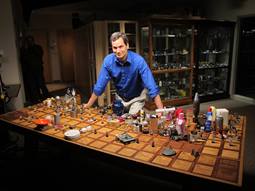Elemental Objects and Astonishing Possibilities
A table is a pretty elemental object, but it can have a world of uses: A setting for a quiet family dinner, a seat, a second desk, an ironing board, a gaming table and sometimes all of the above…at the same time!
What's true for a homey table is also true for the periodic table: Something fairly small and truly elemental filled with the stuff that makes up not just our world, but serves as the basic building blocks of the universe. The periodic table is the focus of David Pogue's newest NOVA special, Hunting the Elements, which recently premiered on PBS (check your local listings).
In a sense, David Pogue (who readers will remember from the Making Stuff series) is hunting a table, which as a rule, is a relatively easy stalk. (Tables rarely move quickly, unless they're accidentally escaping out of the back of a speeding moving truck.) Yet the special is well worth watching, since the track of the elements took Mr. Pogue to some pretty astonishing places, including the Office of Science's Ames Laboratory, the center of the DOE's rare-earth efforts.
Rare-earth elements tend to be found near the bottom of the periodic table, the unpronounceable–ium's such as dysprosium, neodymium, terbium, europium and yttrium. But they're ascendant in importance in clean energy technologies like electric cars and the powerful permanent magnets used in efficient electric motors, as well as modern essentials ranging from lasers to laptops.
That's what makes the work at the Ames Laboratory so important. And that's why Mr. Pogue took a trip to the laboratory, where he talked to physicist Paul Canfield about growing single-crystal rare-earth samples, Larry Jones, the director of the Lab's Materials Preparation Center and "Mr. Rare Earth" himself, Karl Gschneidner. Mr. Pogue also spoke with John Burba, the Chief Technology Officer at Molycorp Inc., the Western hemisphere's only producer of rare-earth oxides, which signed a cooperative research and development agreement, or CRADA, with the Ames Laboratory last year.
"I'm hoping people who don't know a lot about the Department of Energy's (DOE's) national laboratories will watch Hunting the Elements, and learn about the important research going on at the labs, and in particular, the rare-earth research at Ames Laboratory," said Mr. Jones. He added, "Hopefully they'll learn a little more about why DOE research is important to them."
They will. They'll also learn more about the amazing elements set on the periodic table as a whole, from the six essentials that make up most living things (yes, six) to the highly desirables like copper and gold. And yes, Pogue being Pogue, there are a couple of pretty impressive explosions along the way.
So pull up a chair and tune into NOVA's Hunting the Elements…or even better, grab a seat on a table.
The Department's Office of Science is the single largest supporter of basic research in the physical sciences in the United States, and is working to address some of the most pressing challenges of our time. For more information about Ames Lab, please go to: http://www.ameslab.gov/.
Charles Rousseaux is a Senior Writer in the Office of Science.


 Image courtesy of PBS
Image courtesy of PBS